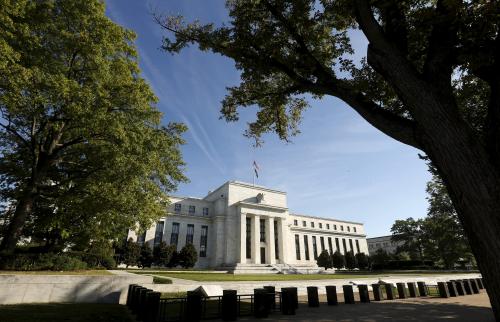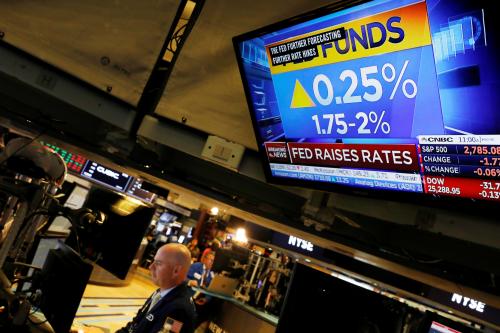This post was originally published on August 14, 2019, and has been updated on June 5, 2020.
The Federal Reserve is considering the monetary tools it will use to bolster the economic recovery from the COVID-19 crisis. The Fed has already reduced interest rates to near zero and used two tools it deployed during the Great Recession—forward guidance and quantitative easing (QE). In addition to these, Fed officials are now talking about yield curve control, sometimes called interest rate caps. Here’s an introduction to yield curve control and how it might work in the United States.
What is yield curve control, and why does it matter?
In normal times, the Fed steers the economy by raising or lowering very short-term interest rates, such as the rate that banks earn on their overnight deposits. Under yield curve control (YCC), the Fed would target some longer-term rate and pledge to buy enough long-term bonds to keep the rate from rising above its target. This would be one way for the Fed to stimulate the economy if bringing short-term rates to zero isn’t enough.
Prior to the COVID-19 crisis, current Fed Governors Richard Clarida and Lael Brainard, as well as former Fed chairs Ben Bernanke and Janet Yellen, said the Fed ought to consider adopting YCC when short term rates fall to zero. New York Fed President John Williams has said that the Federal Open Market Committee (FOMC) is thinking “very hard” about whether it might use YCC this year. Other members of the FOMC have also said they think it could help strengthen the Fed’s forward guidance, which currently says that rates will remain near zero until the Committee is “confident that the economy has weathered recent events and is on track to achieve its maximum employment and price stability goals.” Australia’s central bank adopted a form of YCC in March 2020, in response to the coronavirus, and is targeting a three-year government bond yield of 0.25 percent.
Yield curve control is different in one major respect from QE, the trillions of dollars in bond-buying that the Fed pursued during the Great Recession and is pursuing in 2020. QE deals in quantities of bonds; YCC focuses on prices of bonds. Under QE, a central bank might announce that it plans to purchase, for instance, $1 trillion in Treasury securities. Because bond prices are inversely related to their yields, buying bonds and pushing up their price leads to lower longer-term rates.
Under YCC, the central bank commits to buy whatever amount of bonds the market wants to supply at its target price. Once bond markets internalize the central bank’s commitment, the target price becomes the market price—who would be willing to sell the bond to a private investor for less than they could get by selling to the Fed?
The Bank of Japan (BOJ) committed in 2016 to peg yields on 10-year Japanese Government Bonds (JGBs) around zero percent, in a fight to boost persistently low inflation. To hit that yield target, the BOJ has a standing offer to purchase any outstanding bond at a price consistent with the target yield. On days when private investors for any reason are less willing to pay that price, the BOJ ends up purchasing more bonds in order to keep yields inside the target price range.
The Fed had some experience with interest rate pegs during and after World War II, when the Treasury needed help financing wartime expenditures. In 1942, the Fed and Treasury internally agreed that the Fed would cap the Treasury’s borrowing costs by buying any government bond that yielded above a certain level—at the time, about ½ percent on 3-month Treasury bills and 2½ percent on longer-term bonds. Until around 1947, the Fed was able to maintain these pegs without having to buy up large amounts of bonds. While it would now be considered inappropriate for the Fed to explicitly reduce borrowing costs for the federal government, that experience demonstrates that the Fed could be successful in targeting medium and longer-term rates through purchases. In fact, when Fed staff studied potential unconventional policy options to reduce long-term rates in late 2008, they looked back on this experience as evidence that asset purchases or a similar policy could work.
What do we learn from the Bank of Japan’s use of yield curve control?
The BOJ is the only major central bank to have experimented with interest rate pegs in recent history. YCC is just one piece of the BOJ’s large policy effort that also includes quantitative easing, forward guidance, and negative interest rates—all aimed at lifting inflation. The Bank has been successful at maintaining a yield of zero percent on JGBs.
In addition, YCC has allowed the BOJ to purchase fewer bonds in the last three years than it did under the large quantitative easing program that began in 2013. Until late 2016, the BOJ was purchasing about 100 trillion yen in JGBs each year. As a result, the BOJ’s balance sheet expanded much faster than that of other major central banks.
Since the initiation of YCC, however, the BOJ has purchased government bonds at a slower pace and still kept yields on 10-year bonds at historically low levels. So far in 2020, the Bank is on track to purchase only about 6 trillion yen in government bonds and has been able to respond to the coronavirus downturn by greatly expanding its purchases of other kinds of assets, including corporate bonds and equities. The BOJ experience demonstrates that credible YCC policy can be more sustainable for central banks than a quantity-based asset purchase program.

How would YCC affect the economy?
Interest rate pegs theoretically should affect financial conditions and the economy in many of the same ways as traditional monetary policy: lower interest rates on Treasury securities would feed through to lower interest rates on mortgages, car loans, and corporate debt, as well as higher stock prices and a cheaper dollar. All these changes help encourage spending and investment by businesses and households. Recent research suggests that pinning medium-term rates to a low level once the federal funds rate hits zero would help the economy recover faster after a recession.
But some, including Bernanke, have argued this transmission from the pegged yield to private-sector interest rates would depend on the Fed’s ability to persuade financial markets that it was really committed to the program. For example, say the Fed announced it planned to peg yields on 2-year Treasury securities at zero percent. That means outstanding 2-year notes (which will mature in 2 years or less, by definition) are eligible to be bought at an attractive price. If investors believe the Fed will stick to this program for the full duration of the eligible assets (2 years), then they will begin trading those securities at a price consistent with the peg, because they will be confident in their ability to sell or buy at that price again before the asset matures. In this scenario, the Fed might have to purchase only a limited number of bonds in order to keep prices at the target, and yields on other private-sector securities would be more likely to fall in line with those on government securities.
This raises one attractive feature of the strategy: if investors believe the Fed will stick to the peg, the Fed could achieve lower interest rates without significantly expanding its balance sheet. In theory, if the commitment to the peg were fully credible, the Fed may not have to purchase any bonds at all.
Consider the scenario, however, where investors believe the Fed will have to abandon its peg at some point before the year is up, perhaps because they believe the economy will recover and inflation will rise before that time. Then they would be less willing to buy up 1-year bonds at the Fed’s price, and the Fed would be stuck having to purchase large amounts of the pegged security. In an extreme case, the Fed might have to purchase the entire available supply of such securities.
A similar scenario played out in late 1947, when the Fed raised short-term interest rates in an effort to stem inflation but, as part of its agreement with the Treasury, kept a cap on long-term rates. Higher short rates made the low yields on long-term bonds less attractive, and may have raised doubts among investors that the Fed would stick to its peg. In order to defend its cap on long-term bonds, the Fed ended up buying about $10 billion in Treasuries in the course of about six months (see a 2003 Federal Reserve Staff memo).
What would an interest rate peg look like in the United States?
Although most historical precedents for YCC involve pegs on long-term rates, policymakers have said that the Fed, if it ever adopted some interest rate peg, would be more successful at targeting near or medium-term rates. Governor Brainard said last year, for example, that the Fed could start by pinning the one-year Treasury yield around zero, and then extend the pin to two-year yields if more monetary policy support was needed. This is mainly because the Fed has established that its primary policy tool is the overnight borrowing rate, and any balance-sheet related policy would have to be conducted in a way that is consistent with its expectations about the path for the overnight rate. Targeting a long-term yield like that on the 10-year Treasury would more likely involve a large expansion of the balance sheet, just as it did in 1947. Sustaining such a strategy would require that investors believe inflation and short-term rates will be low for the duration of the peg. In the U.S., targeting shorter-term yields would be easier and more likely to be perceived as a credible policy by the public than targeting long-term yields.
Why has a target on 10-year bonds worked in Japan? One reason is that many private investors in JGBs buy the bonds to hold, rather than trade, them. This implies that some investors—e.g., big institutions who prefer or are required to have a stock of safe government bonds—are willing to hold JGBs even if they expect that short-term rates will rise before the bonds mature. This contrasts with the large and liquid market for U.S. Treasuries, in which investors buy and sell bonds frequently as they update their expectations about rates.
Researchers and FOMC members have also said that a rate peg may be an effective complement to forward guidance and QE, two policies that are already firmly part of the Fed’s toolkit. First, forward guidance and a zero-rate peg on near term-securities are mutually reinforcing, because they both tell markets to expect low rates for a while. Meanwhile, QE could put downward pressure on longer-dated assets than those to which the peg applies. In other words, if used in combination, the three policies could simultaneously lower, flatten, and even out the entire Treasury yield curve (see here for an Explainer on why that matters for the economy).
What are the downsides to YCC?
Like other unconventional monetary policies, a major risk associated with yield-curve policies is that they put the central bank’s credibility on the line. They require that the central bank commit to keep interest rates low over some future horizon; this is exactly why they can help encourage spending and investment, but it also means that the central bank runs the risk of letting inflation overheat while holding to its promise. If the Fed, for example, were to commit to a 2-year peg, they would be betting on the fact that inflation will not run well above its 2 percent target in that period. If it does, the Fed may have to choose between abandoning its promise about the peg or not holding to its stated inflation objective—both bad options in terms of its credibility with the public.
Some of the potential risks associated with QE apply to yield curve control too; for example, both policies require the Fed to add large amounts of assets to its balance sheet. Although the Fed’s experience with QE suggests the side effects of this balance sheet expansion are minimal, the Fed has said that it prefers a smaller balance sheet to a larger one, for multiple reasons. At the same time, however, YCC program could potentially require a smaller balance sheet expansion than would a QE program—if, as described, the peg were credible and it focused on medium-term assets. This is another reason such a policy might be attractive to policymakers in the future.
In short, YCC might be a promising tool to support the recovery from the COVID-19 recession, but only if the Fed can achieve a smooth and credible implementation of the policy.







Commentary
What is yield curve control?
June 5, 2020